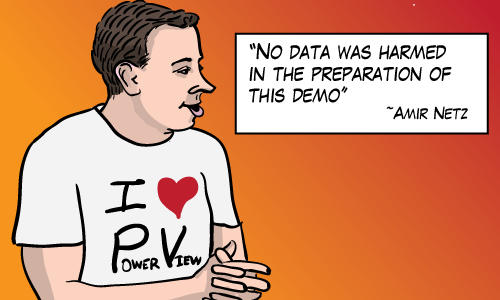So I caught the keynote speech online on the first day of the PASS Summit conference (2011). There were a couple announcements but no big ones. I remember this time last year, many were expecting a release this week. But the big release isn’t until next year. We can now start calling SQL Server codename Denali by its real name, SQL Server 2012. No surprises there. We also learned that the project codename Crescent will be called Power View.
the Power View Demo

You can actually watch the whole keynote here. There’s a demo of Power View near the end. This demo was presented by (new) Microsoft Technical Fellow Amir Netz. He did a good job of presenting what Power View can do. Power View is – among other things – a data visualization tool. Amir gave an updated version of last year’s demo where he explored movie and box-office data.
In Amir’s demo, we learned that:
- Eddie Murphy voices Donkey in Shrek
- Alan Rickman plays Professor Snape
- John Wayne acted a lot.
Basically movie trivia. Amir demonstrated that it’s easy to dig into the data to any depth we want. After the talk, Ted Kummert thanked Amir and called the demo fun. It was a good demo, but it wasn’t a great demo. A lot of it was interesting, Amir and his team are clearly passionate about the product, but the best reactions on twitter could be summed up as “neat!” rather than “wow!”
Compare that to Hans Rosling
Hans Rosling gave a TED talk in 2006 called “Debunking third-world myths with the best stats you’ve ever seen” Several people on Twitter compared this TED talk to today’s keynote.
The data technology that Hans uses is something he developed called Gapminder. On the surface, it’s the same as Power View. As Hans speaks, we learn:
- By most metrics, countries we think of as third-world are equivalent to 1960s U.S.A.
- The term “developing country” carries a meaning with most people that’s not useful today.
- There’s tremendous variation in regions (like sub-Saharan Africa, Arab states, etc…). A distinction that we rarely make.
Now that’s a great talk. Hans is a statistician first (not a B.I. expert). He demonstrates the power of data to illuminate topics and solve problems.
The Difference
So what takes Hans Rosling from good to great? What’s the difference between today’s keynote demo and the TED talk?
- Both presenters are passionate and enthusiastic. There’s no faulting them there.
- Only during the TED talk did I imagine myself solving problems. (Like using data to improve software quality… Lean-manufacturing style!)
- There’s a difference in the importance of the data used in the examples…
A Parallel in the Teaching of Poetry
I’m reminded of something from the world of poetry actually. A poet, James Fenton, wrote a textbook called: An Introduction To English Poetry. In it, he gives advice to poetry teachers about the best examples of poetry to give poets-in-training. For illustration, Fenton talks about a particular form of poetry, the villanelle. What’s a villanelle? It’s a 19 line-poem with a very particular form including many repetitive lines. Here are two examples (from the public domain):
by Dylan Thomas
Do not go gentle into that good night,
Old age should burn and rage at close of day;
Rage, rage against the dying of the light.
Though wise men at their end know dark is right,
Because their words had forked no lightning they
Do not go gentle into that good night.
Good men, the last wave by, crying how bright
Their frail deeds might have danced in a green bay,
Rage, rage against the dying of the light.
Wild men who caught and sang the sun in flight,
And learn, too late, they grieved it on its way,
Do not go gentle into that good night.
Grave men, near death, who see with blinding sight
Blind eyes could blaze like meteors and be gay,
Rage, rage against the dying of the light.
And you, my father, there on the sad height,
Curse, bless me now with your fierce tears, I pray.
Do not go gentle into that good night.
Rage, rage against the dying of the light.
by William Ernest Henley
A Dainty thing’s the Villanelle,
Sly, musical, a jewel in rhyme,
It serves its purpose passing well.
A double-clappered silver bell
That must be made to clink in chime,
A dainty thing’s the Villanelle;
And if you wish to flute a spell,
Or ask a meeting ‘neath the lime,
It serves its purpose passing well.
You must not ask of it the swell
Of organs grandiose and sublime–
A dainty thing’s the Villanelle;
And, filled with sweetness, as a shell
Is filled with sound, and launched in time,
It serves its purpose passing well.
Still fair to see and good to smell
As in the quaintness of its prime,
A dainty thing’s the Villanelle,
It serves its purpose passing well.
You don’t have to be an English major to tell which one of those poems is inspiring, and which one isn’t. Fenton argues that “…if you start from Thomas’s villanelle as a model, you will be setting your sights much higher than if you start from Henley.” And he’s quite right, people take cues from examples like these.
Thinking About Examples
Back to B.I. demos. Not every example in every talk in every conference has to change the world. But if you’re introducing a powerful new tool like Power View in a keynote, maybe “nifty” or “neat” isn’t the impact you’re aiming for. I wonder if there’s a missed opportunity here for Microsoft to inspire. I wonder what Amir Netz’s demo with Hans Rosling’s data would have looked like? In that hypothetical scenario, I bet Power View users who saw that demo would then be more likely to start projects that make people say “Wow!” instead of simply “Neat!”




